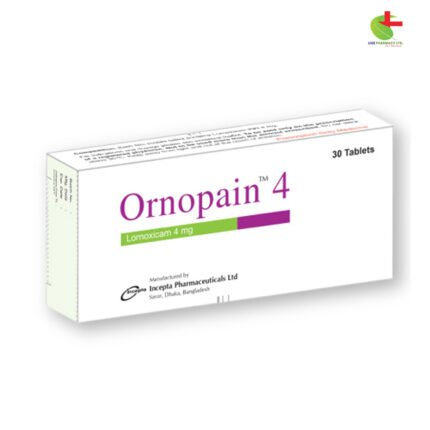Ornopain 8
250.00৳ Strip
- Ornopain (Lomoxicam) is a non-steroidal anti-inflammatory drug (NSAID) used for the short-term relief of mild to moderate pain, as well as pain and inflammation in osteoarthritis and rheumatoid arthritis.
- It works by inhibiting the production of prostaglandins, which are responsible for pain and inflammation.
- Ornopain is available in tablet form and is typically taken in divided doses, depending on the condition being treated.
- Always use under the guidance of a healthcare professional.
 Brand
Brand
|
Incepta Pharmaceuticals Ltd |
|---|---|
 Generics
Generics
|
Lornoxicam |
 Type
Type
|
Tablet |
Indications
Ornopain is an effective treatment for:
- Short-term relief of acute mild to moderate pain
- Symptomatic management of pain and inflammation in osteoarthritis
- Symptomatic relief of pain and inflammation in rheumatoid arthritis
Always use under the guidance of a registered healthcare professional.
Pharmacology
Lomoxicam, a non-steroidal anti-inflammatory drug (NSAID) from the oxicam class, is designed for short-term relief of acute pain and symptoms associated with osteoarthritis and rheumatoid arthritis. Its mechanism of action primarily involves the inhibition of cyclooxygenase (COX), leading to reduced prostaglandin synthesis. This results in a decrease in inflammation and pain, while helping desensitize peripheral pain receptors.
Dosage & Administration
- Acute Pain: The recommended starting dose is 8–16 mg of Lomoxicam daily, divided into 2 or 3 doses. The maximum recommended dose is 16 mg per day.
- Osteoarthritis & Rheumatoid Arthritis: Begin with a dose of 12 mg daily, divided into 2 or 3 doses. The maintenance dose should not exceed 16 mg per day.
- Children & Adolescents: Lomoxicam is not recommended for children under 18 due to limited safety and efficacy data.
- Elderly: No special dose adjustments are necessary, though caution is advised due to increased susceptibility to gastrointestinal side effects.
- Renal Impairment: In patients with mild to moderate renal impairment, the maximum recommended dose is 12 mg per day, divided into 2 or 3 doses.
- Hepatic Impairment: Patients with moderate liver impairment should not exceed a daily dose of 12 mg, divided into 2 or 3 doses.
Interaction
- Warfarin & Vitamin K Antagonists: Increases bleeding risk when used together.
- Cyclosporine: Can reduce kidney function and increase the risk of kidney injury.
- Lithium & Methotrexate: Lomoxicam can amplify the adverse effects of these drugs.
- Diuretics & ACE inhibitors: May have reduced effectiveness in patients with heart failure.
Contraindications
- Known hypersensitivity to Lomoxicam or its components
- Peptic ulcers or active gastrointestinal bleeding
- Severe renal or hepatic impairment
- Thrombocytopenia
- Pregnancy (third trimester)
Side Effects
Common side effects include gastrointestinal issues such as nausea, vomiting, diarrhea, constipation, and abdominal pain. Serious side effects may include peptic ulcers, gastrointestinal bleeding, and perforation, especially in elderly patients.
Pregnancy & Lactation
- Pregnancy: Lomoxicam is contraindicated in the third trimester and should be avoided during the first and second trimesters unless absolutely necessary.
- Lactation: It is unknown whether Lomoxicam is excreted in human breast milk. As it is excreted in milk in rats, it is not recommended for breastfeeding women.
Precautions & Warnings
- Use with caution in individuals with kidney issues, hypertension, heart failure, gastrointestinal diseases (e.g., Crohn’s disease), asthma, or a history of bleeding.
- Women undergoing fertility treatment should also avoid Lomoxicam.
Overdose Effects
In case of overdose, symptoms may include nausea, vomiting, dizziness, and visual disturbances. There is no specific antidote for Lomoxicam overdose, and it is rapidly excreted due to its short half-life. Gastric lavage may be considered in severe cases.
Therapeutic Class
Non-Steroidal Anti-Inflammatory Drugs (NSAIDs)
Storage Conditions
Store at or below 30°C, away from light and moisture. Keep out of reach of children.













Reviews
There are no reviews yet.